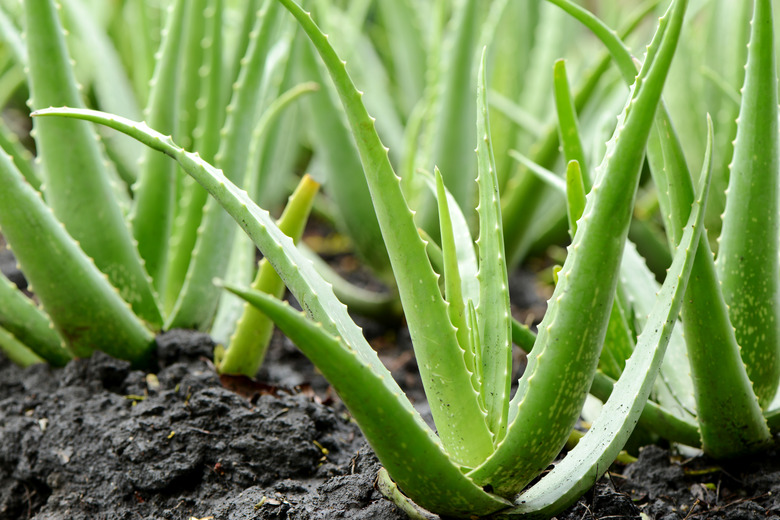How Do Aloe Plants Reproduce?
Aloe vera plant seeds are rarely used to propagate this useful and popular succulent, as the plant reproduces easily by removing and potting the prolific offsets. An outdoor perennial in United States Department of Agriculture zones 10b to 12a, aloe vera (Aloe vera) is grown as a houseplant by people all over the world.
Grown commercially for the gel in its leaves, aloe vera is used in a wide variety of ointments, cosmetics and medicines. A traditional remedy for burns, sunburn and acne, aloe gel will ooze from the fleshy leaves if the foliage is split or broken off the plant. An easy keeper, aloe plants like bright sun and dry soils.
Aloe Vera Sprouts
Aloe Vera Sprouts
Aloe vera is a low-growing succulent, with a rosette of fleshy leaves. The speckled, serrated leaves are eight to ten inches long, and mature plants can reach a size of two feet high by one foot wide.
Rhizomes spread underground, sprouting offsets around the base of mature plants. These offsets are commonly referred to as 'pups.' An asexual method of reproduction, aloe vera pups are like tiny plant babies.
Once aloe vera pups are a couple of inches tall, they can be removed from the mother plant with a clean, sharp knife. Allow the cut on the pup to heal for a couple of days, then move to a new pot filled with succulent potting soil. Be sure to use a potting soil made for succulents, as this will help keep your plant well-drained between waterings. The aloe vera pup will grow roots after about a month, making a great gift for a friend or relative.
Do Aloe Plants Flower?
Do Aloe Plants Flower?
Aloe plant flowers will develop on mature plants that are grown in bright light. Aloe spikes can reach heights of three feet, rising up from the rosette of leaves to form a showy cluster of aloe plant blooms.
The individual flowers are tubular, and they are arranged in a raceme at the top of the spike. Ranging in color from red to pink to coral or orange, the blooms are likely to appear in the spring or winter. A mature plant will bloom a few times over the course of its life if conditions are right.
Although aloe plants can be propagated by aloe seed, this method is not common. It's difficult to maintain the light, temperature and moisture conditions needed to germinate and grow aloe from aloe vera seeds, so this propagation technique can be challenging if you don't have a greenhouse.
Healthy aloe plants will produce many pups, so dividing them off a mature plant and repotting them is the easiest way to grow more aloe. The flowers are bright and fancy, but collecting seeds and trying to start them is usually not worth the time and effort.
Caring for Aloe Vera
Caring for Aloe Vera
Aloe vera is among the easiest houseplants to grow, so it's a good plant species to start with. If you have a friend or neighbor with a mature aloe plant, ask if you can have an aloe 'pup' to experiment with.
After your aloe pup develops roots, keep your plant in a sunny window. A south-facing window is best, but east- or west-facing windows should also work. Aloe vera plants need bright light to thrive and bloom, and they will not do well in temperatures below 50 degrees Fahrenheit.
Rotate your plant periodically to make sure all parts of the plant get light. Water more during the summer, completely soaking the soil. Allow the potting soil to completely dry out between waterings, and water less frequently during the winter months.
Once your aloe plant reaches maturity, you can move it outside to a porch or patio during the summer. Just remember to bring your aloe back inside before temperatures dip below 50 degrees, as the cold can burn leaf tips or cause discolored foliage.
Cite This Article
MLA
Sloane, Christina. "How Do Aloe Plants Reproduce?" sciencing.com, https://www.sciencing.com/how-do-aloe-plants-reproduce-13428303/. 30 September 2021.
APA
Sloane, Christina. (2021, September 30). How Do Aloe Plants Reproduce?. sciencing.com. Retrieved from https://www.sciencing.com/how-do-aloe-plants-reproduce-13428303/
Chicago
Sloane, Christina. How Do Aloe Plants Reproduce? last modified March 24, 2022. https://www.sciencing.com/how-do-aloe-plants-reproduce-13428303/
